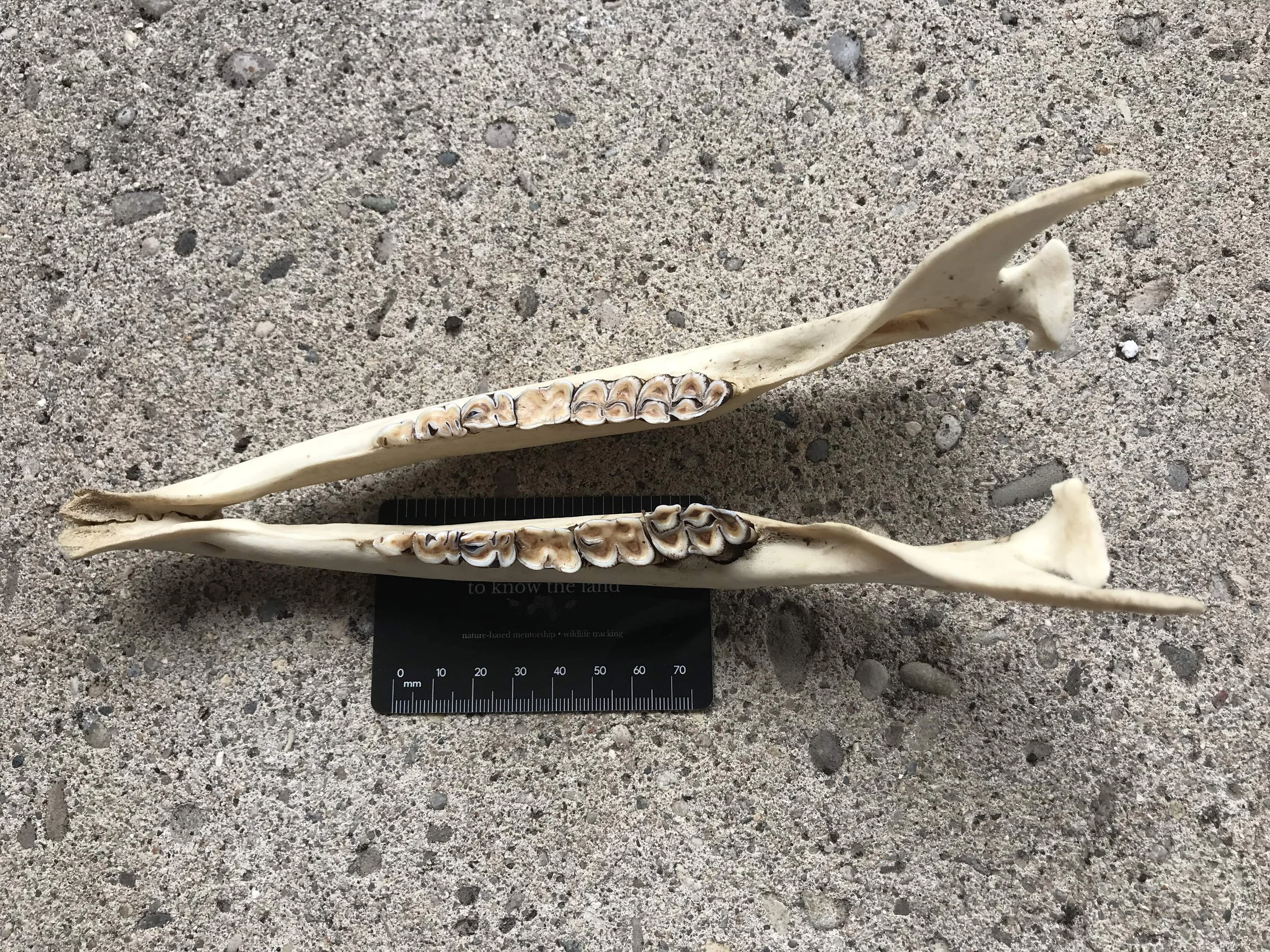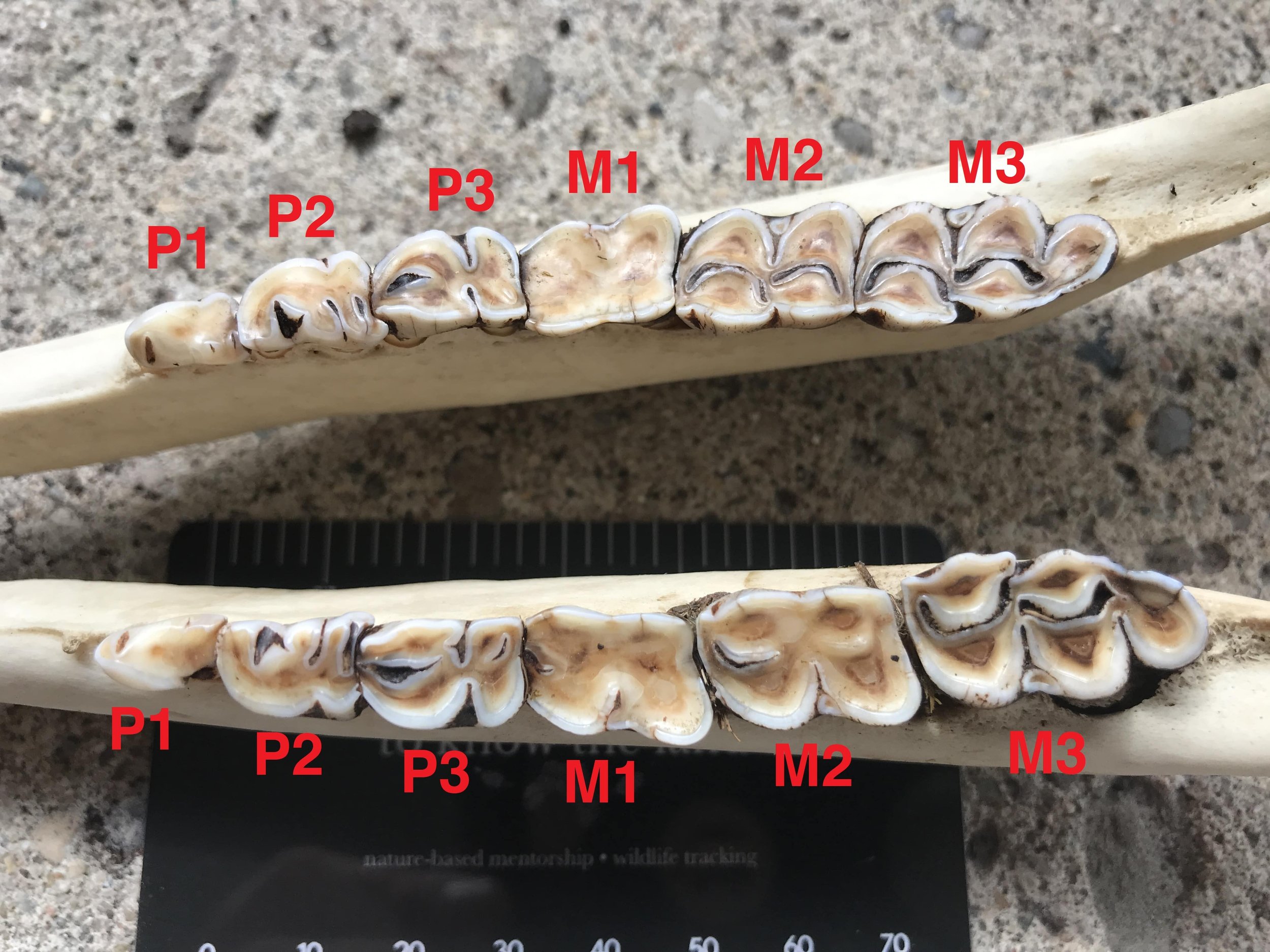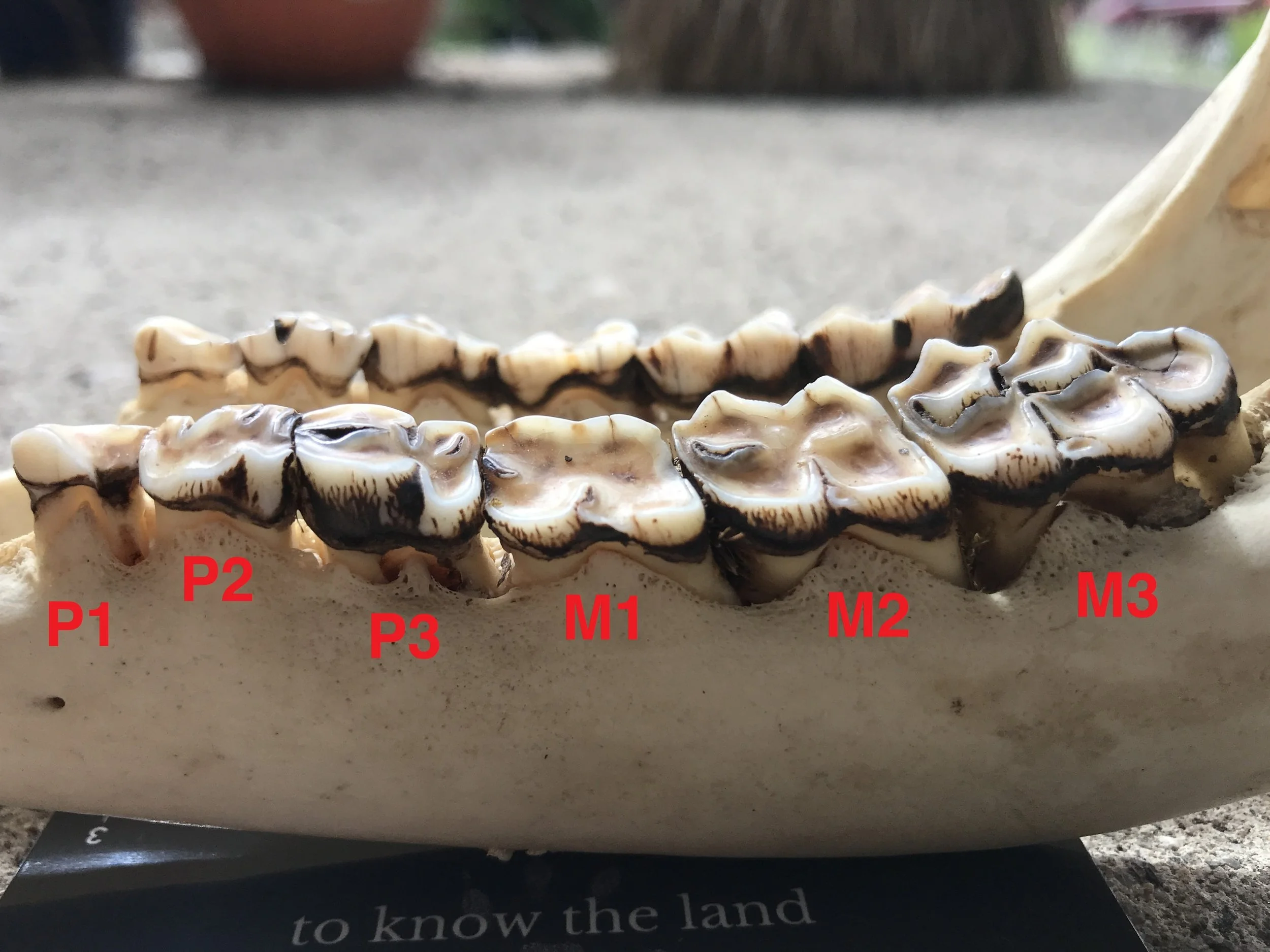How To Age A White-tailed Deer by Looking At The Teeth pt. 2 : Older Deer
This is part 2 of 2 of posts relating to aging White-tailed Deer by looking at the teeth in lower mandibles. I will be using terminology and concepts explained in the first part Check out part 1 here.
Cleaned lower jaw of White-tailed Deer (Odocoileus virginianus) we found at a Track and Sign eval in April, 2024.
At the end of April I was attending a Track and Sign Evaluation hosted by Earth Tracks. On the second day of the two day eval we came across a female White-tailed Deer (Odocoileus virginianus) carcass and were asked the question of how old the dead Deer was when she died. We were given three options to choose from based on what we could see. Note the image below was taken in the field and shows flesh and decay of the lower jaw and upper palate.
The three options were: A) 1-3 years, B) 4-7 years, or C) 7 and up.
I ended up taking a bit of time on this question. I could tell that this doe had not died young. For the younger deer, it’s all about which teeth are present. I had to ask the three big questions we covered in the first post of this series : Are there less than six teeth? The deer is then a fawn. Does the third premolar have three cusps? The deer is between 1.5 - 2.5 years old. Does the third premolar have two cusps? The doe was older than 2.5 years old. Looking at this mandible I could see that all six teeth were present and the second premolar had 2 cusps, meaning the deer was at least older than 2.5 years old. I also noted that some of the teeth were really worn down. This helped. When aging deer older than 2.5 years old we stop looking at which teeth are present and, in general, move on to how worn down are the teeth. There are some important terms we should start with first, and those are enamel and dentin.
Enamel is the glossy, smooth white part of the outside of the teeth. This protects the inside of the tooth as enamel resists wear.
Dentin is the softer inner core of the tooth and is covered and preserved by the dense enamel which enwraps the outside of the tooth. The dentin is darker than the enamel and presents as a creamy pale brown.
Infundibulum is a funnel shaped depression in the center of the crown of a tooth between the lingual crest (tongue side) and the buccal crest (cheek side). This will be important to inspect for the oldest of deer.
As deer age, the enamel wears away and the dentin is exposed. To age a deer older than 2.5 years old we look at a couple of things: how much of the dentin is exposed, how wide the dentin appears compared with the enamel, and on which teeth as a reliable clue to the general age of the deer.
White-tailed Deer biologist Brian Murphy describes the wear process like this:
“[T]hink about a sharp mountain peak with the crest of that mountain, or the outer coating, being the enamel and the dark inner core of that material being the dentin, that will give you an idea of what we're looking at. Imagine that sharp mountain peak slowly being eroded over time, and as that peak gets worn it appears that the dentin gets wider and wider as that tooth gets closer to its base.”
Just to note, I am using a couple of different sources from here out and they are all linked at the bottom of the post. Some sources will offer a descriptive feature that other sources may not. I am trying to consolidate descriptions of tooth wear that are consistent or standard across many sources, which I interpret as likely being more acceptable or considered accurate in a field testing/evaluation setting. On with the show!
Superior (top down, or birds-eye) view of both mandibles the lower jaw.
Again to determine the age of a deer up to 2.5 years old, check out my previous post here.
3.5 years old
To determine if a deer is roughly 3.5 years old, we look to M1, the fourth tooth from the distal (furthest away from the core of the body) end of the mandible. The dentine should be as wide or wider than the enamel of the tooth.
4.5 years old
If a deer is roughly 4.5 years old, look to the fifth tooth. The enamel on the fifth tooth should be so worn away that the dentine is as wide or wider than the enamel. The sixth tooth should not be as worn down, and the enamel should be as wide or wider than the dentine.
5.5 years old
Following the same pattern as the two above, to know if a deer is roughly 5.5 years old, we’ve got to look at the sixth tooth, M3, the only tricuspid in an adult White-tail. You know what to do. If the enamel has worn away enough that the dentine is as wide or wider than the enamel, than this deer is at least 5.5. years old.
This is my current edge. How do I figure out beyond the regular pattern of tooth wear on the six teeth available? What do I look for next?
6.5 years old
From what I am learning, to determine the 6.5 year old and older, you look again to the molars. If all three molars are worn and the cusps flattened, and if M1 (fourth tooth) is so worn down that it appears “dished out” (think of like a plate or a shallow bowl) with no enamel ridge showing between where the cusps once were, than the deer is at least 6.5 years old. This characteristic seems consistent with many sources.
One source I read says at this point the “small enamel ridge will be present in center of tooth 5 and tooth 6. Lingual crest on tooth 5 is almost worn away and rounded in tooth 6.”
While I do see the “small enamel ridge will be present in center of tooth 5”, which is a bit more pronounced tooth 6 or M3, I don’t know about the wear on the lingual side of tooth 5. If it’s supposed to be almost worn away, it’s not. It’s still pretty present, and the note about how the lingual crests on tooth 6, M3, supposed to be rounded? Not really. I would suggest the the rounded edges on tooth 5, M2, would make sense for the description, but not so much M3.
It is important to remember that this isn’t going to be exact all the time. The aforementioned comment on the dished out M1, tooth 4, is consistent across many sources as being found on a deer aged 6.5 years and up so we can use that as a touchstone for going forward from here.
7.5 years old
For 7.5 year old deer, teeth 4 and 5, M1 and M2, will be worn smooth, both dished out. There should also be no enamel ridges present in between these teeth. Think of them being worn flat and now on a single plane.
Because it is essential for balanced learning, I want to complicate the descriptions above a little.
When we were listening to Daniel Hanche (who uses they/them pronouns - just elaborating for clarity) explain how they read the age of the deer, Daniel mentioned that in their time working at deer check stations (where hunters bring in newly killed deer so conservation officials can take measurements, tissue samples and gather info about local deer populations) the male deer Daniel saw tended to have more worn out teeth than the females at comparable ages. To reiterate, the male deer’s teeth would generally wear down faster than the female deer. This is confirmed in a paper I have found online about White-tails. I found another paper about Red Deer (Cervus elaphus) which mentioned that “…larger mandibles were related to higher rates of dentine wear, suggesting increased body size was associated with greater intake and processing of food.”
We shouldn’t throw out the baby with the bath water, but instead remember that tooth replacement theory seems to hold water, but the tooth wear seems to have some holes in it. This is a good thing to remember when we’re out, doing our best to figure out the ages of the deer whose mandibles we are lucky to find.
Big thanks to all my tracking companions, Daniel Hanche and the deer themselves for sharing their thoughts and bones with me. I am forever in awe.
To learn more :
How To Age A White-tailed Deer by Looking At The Teeth pt. 1
White-tailed Deer Jaw Bone Aging pt. 2 by QDMA pt. 2 : Tooth Wear (video)
Texas Parks and Wildlife A Guide to Age Determination of White-tailed Deer (pdf)
Sex Affects Age Determination and Wear of Molariform Teeth in White-Tailed Deer by Timothy R. Van Deelen, Karmen M. Hollis, Chris Anchor and Dwayne R. Etter
The influence of habitat on body size and tooth wear in Scottish red deer (Cervus elaphus) by F.J. Pérez-Barbería, S.L. Ramsay, R.J. Hooper, E. Pérez-Fernández, A.H.J. Robertson, A. Aldezabal, P. Goddard, and I.J. Gordon
Penn State University Deer and Forest Research blog post about the inadequacies of aging deer by tooth wear




